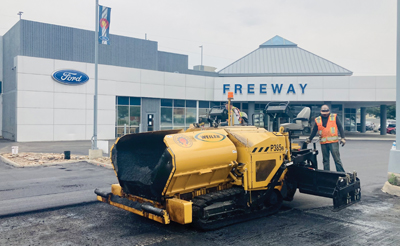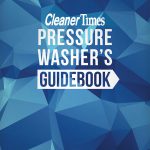
Power Washer’s Guidebook
Cleaning Asphalt Surfaces
By Terri Perrin / Published September 2023
Contributor: Luke Miller, Colorado Paving Solutions, Denver, CO
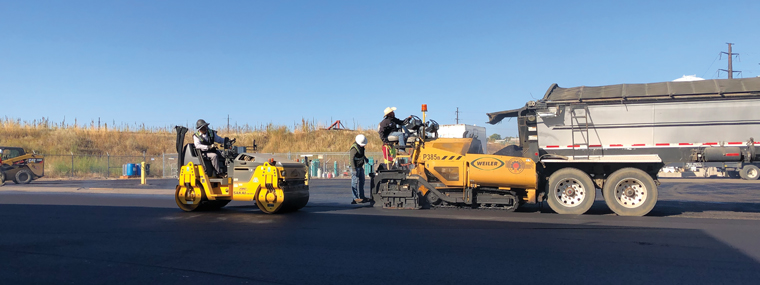
Asphalt is one of the top two paving options in the world and for good reason. It’s strong, affordable, and great looking. Beautiful and shiny blacktop increases curb appeal and makes both commercial and residential properties look amazing.
“But clean, beautiful asphalt that lasts multiple decades won’t happen unless property owners take care of minor chores, like cleaning and sealcoating asphalt surfaces,” warns Luke Miller of Colorado Paving Solutions. “While it may look like a simple task, there is much for the professional pressure washing service provider to consider before they start cleaning asphalt.”
Geographical Considerations
Cleaning asphalt is an opportunity open to service providers across North America. But be aware that some municipalities have specific guidelines for power washing contractors relating to the Clean Water Act. Check with local representatives of the Environ-mental Protection Agency (EPA) to learn regional/local requirements.
Areas with snow and cold winters, where road sand/salt or chemicals are used for ice control, must also factor that into your cleaning strategy. Be sure to dry sweep debris first. Leaving sand, salt, and chemicals on asphalt prior to pressure washing is not advised.
Typical Job
Asphalt cleaning jobs are often done in conjunction with commercial building cleaning projects or residential properties.
The size and scope of these projects may vary widely. The most important thing to be aware of is that asphalt is a petroleum-based product that does not respond well to caustic chemicals, which can dry it out and cause it to lose its integrity.
The following chemicals must be avoided:
- Degreasers (used to clean restaurants)
- Chlorine (used to counter the growth of algae and mold)
- Oxalic acid or RustAid® (used to inhibit rust), and
- Diesel fuel.
Asphalt Cleaning Step By Step
Step 1—Pre-Check
Walk the area to check for pitting, pockmarks, gouges, cracks, and raveling asphalt. Raveling is the deterioration of pavement by the loss of asphalt and rocks, evident by tiny rocks and sand on the pavement surface and in gutters. Over a period of time, the thickness of the pavement begins to dwindle until the entire pavement has eroded completely.
Circle problem areas with chalk and try to stay away when pressure washing because the force of the water can worsen current problems. Take photos and show problem areas to your client prior to pressure washing.
If possible, aim to have these issues fixed by an asphalt contractor prior to pressure washing, or learn how to do this properly. Using infrared heat and striping can be a cost-effective way to both take care of asphalt and enter the asphalt maintenance marketplace as a value-added service … but you need to know how to do this. It will require an investment in additional equipment and training.
Step 2—Clear the Area
Remove furniture, planters, trash cans, etc.
Dry sweep with a push broom or leaf blower, and then rinse debris with a garden hose to dislodge residue (dirt, sand, pollen, etc.). The more loose debris you remove, the better the asphalt will take to cleaning.
Step 3—Clean Stains
Use absorbent kitty litter or asphalt-appropriate degreaser to remove oil and other stains.
Be aware that you may have a tough time eliminating oil stains without pre-treatment and could damage the asphalt if water pressure is concentrated in one spot for too long.
Step 4—Pressure Wash
Warning: Asphalt is strong but not invincible. Turn your pressure washer setting to the lowest psi that still cleans dirt and grime from the asphalt. High settings could cause damage or make existing problems worse.
Repeat! Avoid spraying in one spot for too long.
Work methodically, from one side to the other.
If the surface is sloped, begin on the high side and work your way to the low end.
Be aware that too much pressure can also cause mulch and dirt to lift from surrounding areas to drain back onto the clean area.
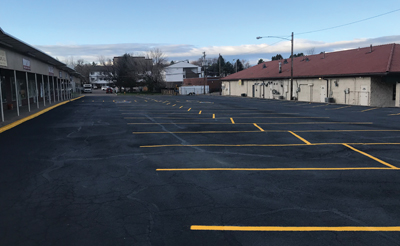 Pressure Washing Techniques That Work Best
Pressure Washing Techniques That Work Best
Most professional power washing companies use a ball valve with a swivel. The ball valve allows the technician to transition between the gun and the flat surface cleaner without having to walk back to the machine to turn it off, change the gun/ hover, walk back to the machine, and then turn it on.
The swivel connected to the ball valve allows the high-pressure hose to turn and move freely. By cutting the ball valve at a 45-degree angle, the technician will create a pressure that is ideal for rinsing. This method circumvents the problem of getting too much pressure from a gun. For wide-open areas, a gun should not be ruled out. It is often a safer choice. On the other hand, for a large, flat area an operator may become fatigued more readily using this technique.
Every method has advantages and disadvantages, and each operator will have to discover which works best for most jobs. Keep in mind that there is risk involved with cutting the ball valve at a 45-degree angle; that shortens the life of the tool. If the ball valve and swivel option is used, there is a risk that if an operator loses his grip and the pressurized water continues to spray, then the live hose could potentially hit the face of the operator. In contrast, if the contractor loses his grip on the gun, the gun immediately shuts off.
Alternatives To Pressure Washing Asphalt
Pressure washers make quick and thorough work of cleaning a driveway, but in difficult-to-access areas or special circumstances, hand cleaning (and “elbow grease”) may be required. You will need a large bucket, a push broom/brush, and asphalt-appropriate cleaner from your local pressure washing supplies distributor. As with pressure washing, work methodically from one area to the other and uphill to downhill.
Follow the directions for the cleaning solution and get prepared to sweat while you scrub caked-on dirt.
After you’ve finished scrubbing, work down the driveway again with a garden hose and spray off the excess residue.
Equipment and Supplies
Basic equipment is either a pressure washer or a flat surface cleaner in the range of 1000 to 3000 psi, with normal accessories. To achieve good results with very localized and heavy oil or grease residue, a hot water washer may be a good addition (to couple with asphalt-compatible presoak chemicals). Companies that do a lot of asphalt work will probably want to invest in more than one type of tool to allow the machine to be matched precisely to the task. To meet EPA requirements in a particular geographic area, many contractors will need containment devices, vacuums, and possibly a wastewater collection system.
Exceptions
There is a big difference between a job in which a client requests removal of dirt and debris from asphalt (akin to the “street washing” that many municipalities undertake at least annually with heavy, wet-sweeper equipment) and specific requests for asphalt cleaning. You may be limited in how much help you can provide to clients with specific requests for cleaning asphalt.
You may be asked to solve one of several difficult cleaning problems: oil from a leaky vehicle, rust from a well or reclaimed sprinkler system, or graffiti. Unfortunately, there are limitations to resolving all of these problems.
Oil stains are usually cleaned by employing a dry, absorbent material. Ensure the material is properly disposed of according to EPA guidelines.
Rust marks can be treated with oxalic acid. But, remember that asphalt is easily damaged by caustic chemicals! At most, use a very limited amount of acid in a contained area of the asphalt. Because asphalt also does not respond well to high pressure, using high pressure on asphalt should be done only in extreme cases and only to remove thick layers of coating.
Paint overspray or paint-based graffiti may be cleaned with higher pressure. If it doesn’t work, explain to your client that paint may need to be treated in the same way a tattoo removal expert hides a tattoo, by masking it with paint that mirrors the surrounding area. Consult an expert at a local paint store for guidance. Miller says that they often paint black over errant paint on asphalt and/or sealcoat over it with asphalt sealer, but both will fade over time and reveal the old paint that was just covered up.
How To Bill
Depending on your regional location, water access, size/difficulty of the job, and the time it takes to complete the job, the charge for cleaning/rinsing will likely fall within the range of 5 cents to 20 cents per square foot. Charges for specialty work—such as presoaks of grease spots—will have to be set separately according to the cost of materials and the estimated time to complete.
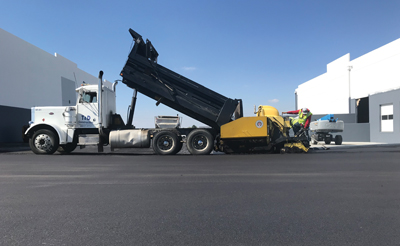 Ancillaries
Ancillaries
Asphalt cleaning is typically the add-on service for a contractor for restaurants, commercial properties, or retail business maintenance. Rinsing asphalt parking areas when on the job is a good way to impress customers by going the extra step.
House cleaning contractors can look at the opportunity to rinse asphalt driveways as a service that might be added to the primary project.
For contractors looking for a new source of revenue, offering a service that incorporates presoak chemicals for grease spots makes sense if there is a sufficiently large niche for the service.
Small “cold patch” kits (for very small potholes) may be available at your local hardware store in ready-to-use containers, much like ready-to-use concrete. Do your research before attempting this type of work.
Patching with hot mix asphalt (for larger potholes) is skilled labor and not advisable if you have not been properly trained. It also requires skid steers, steam rollers, tandem dump trucks, rakes, shovels, and some fairly expensive insurance—and it must be done quickly after the asphalt has left the plant that manufactured it. So, it is not a good value-added option.
Resealing asphalt is a value-added service that pressure washers could offer, advises Miller. “Sealing asphalt provides a fresh, new layer on top that not only looks great but protects it from fading, gouging, and raveling,” he says. “Applying sealer is much like pressure washing. It’s stored in a specialized trailer tank and applied with a spray wand.”
Some homeowners attempt to clean and reseal their driveway themselves. But it’s recommended to leave resealing asphalt to a professional who can inspect the surface, fix any issues that could affect resealing, and then apply a sealcoat professionally to make the asphalt look brand new.
Line painting is another possible ancillary service; however, it will require about a $5K investment in new equipment. You also need a thorough understanding of the basic rules pertaining to the Americans with Disabilities Act (ADA) compliance (for wheelchair parking areas) and basic parking standards. After the initial dry sweep and power washing—allowing sufficient drying time—a seal coat is applied. If existing lines are faded/chipped/peeling, you can just restripe over them. If new lines need to be applied, be certain you are aware of the parking standards. For general line painting guidelines, check with your local municipality. Learn more about ADA parking at https://adata.org/factsheet/parking.
Problems To Avoid
Ensure a prospective client understands what can and cannot be achieved by rinsing asphalt with water or tackling specific areas of the asphalt to remove grease, graffiti, or rust.
Share information about the nature of asphalt—that it’s a petroleum-based product—so that the customer understands the limitations in removing certain kinds of blemishes and residues.
And, always take care of the basics—show up on time and try to find a way to solve the client’s problem.
Luke Miller is the co-owner of Colorado Pavement Solutions in Denver, CO. He has been in the asphalt and concrete business for 10 years, specializing in right-of-way road repairs and paving, new commercial development paving, commercial parking lot maintenance and repairs, and residential driveway paving. https://copavementsolutions.com.
Asphalt Versus Concrete. What’s The Difference?
Concrete deteriorates with use of salt, which is spread on roads to melt snow and ice. Asphalt, on the other hand, is not affected by the cold and does not deteriorate from salt use. Asphalt pavement absorbs more heat from the sun, causing snow and ice to melt much more quickly than on concrete.
Asphalt has various other names. Pitch, tarmac, blacktop, and pavement all mean roughly the same thing. Liquid asphalt is often called tar.
On a lighter note, Canadians pronounce this word “ASH-fault,” probably because they are too modest to say “ASS-fault” like their American counterparts.
Pressure Washer’s Guidebook
For more content like this, be sure to check out our Pressure Washer’s Guidebook. This resource is available in both print and digital formats and contains over 50 chapters, a chemical glossary, and a marketing glossary for the contract cleaners. The PWG also includes 16 chapters devoted to help you in a very detailed manner to market your business followed by more than 25 chapters written by contract cleaners, providing tips on the typical job, techniques that work best, how to bill, how to fix mistakes, and more.

